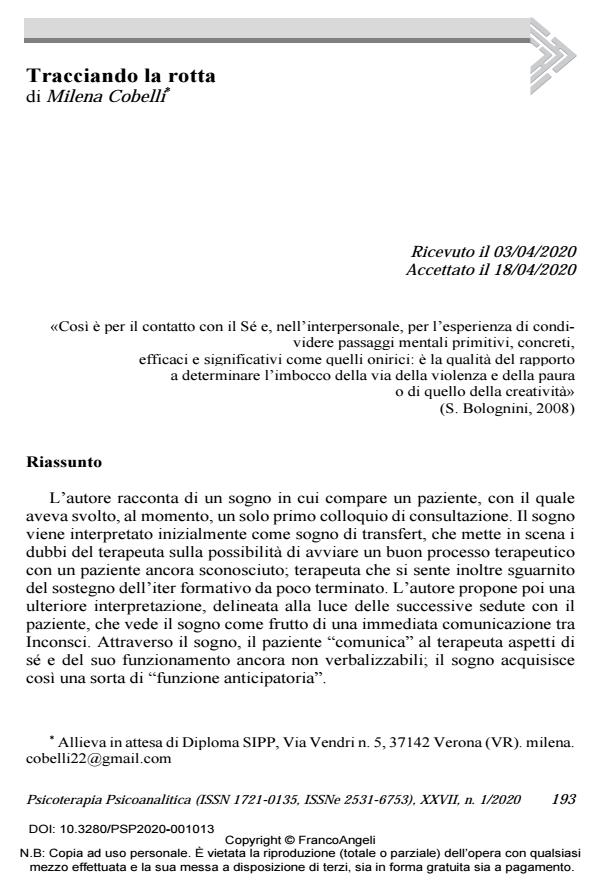Plotting the way
Journal title PSICOTERAPIA PSICOANALITICA
Author/s Milena Cobelli
Publishing Year 2020 Issue 2020/1 Language Italian
Pages 13 P. 193-205 File size 185 KB
DOI 10.3280/PSP2020-001013
DOI is like a bar code for intellectual property: to have more infomation
click here
Below, you can see the article first page
If you want to buy this article in PDF format, you can do it, following the instructions to buy download credits

FrancoAngeli is member of Publishers International Linking Association, Inc (PILA), a not-for-profit association which run the CrossRef service enabling links to and from online scholarly content.
The Author recalls dreaming about a patient she has just seen in first consultation. Initially, the dream is interpreted as a transference dream showing the therapist’s doubts about the possibility to start a good ther-apy with an unknown patient; the therapist also feels deprived of the support of the recently completed training process. The Author then proposes a further interpretation, outlined in the light of the following therapy sessions with the patient, according to which the dream is seen as the result of an immediate communication between their subcon-scious minds. Through the dream, the patient "communicates" to the therapist aspects of his own self and functioning that have not been verbalized yet; the dream thus acquires a sort of "anticipatory function". This paper aims to highlight how this dream, on the one hand, sug-gested how to prepare for the clinical meeting, and on the other hand, how this dream also performed the function to show the therapist how to begin and proceed in the therapeutic work with the patient she dreamt of.
Keywords: Psychoanalyst’s dream, transference dream/countertransference dream, first consultation, subconscious communication, starting therapy.
- Bion W. (1965). Trasformazioni. Roma: Armando, 2012.
- Bolognini S. (2008). Passaggi segreti. Teoria e tecnica della relazione interpsichica. Torino: Bollati Boringhieri.
- Borgogno F. (1997). Un contributo di Ferenczi alla psicoanalisi infantile: la pensabilità del trauma e del traumatico. Richard e Piggle, 5 (3): 276-285.
- Brown L.J. (2004). The point of interaction, mutuality, and an aspect of the analyst’s oedipus conflict. The Scandinavian Psychoanalytic Review Journal, 27 (1): 43-51. DOI: 10.1080/01062301.2004.1059293
- Cabré L.J.M. (2011). La funzione traumatolitica del sogno. Rivista di Psicoanalisi, 57 (2): 395-399.
- Ferenczi S. (1934). Riflessioni sul trauma. In: Opere (vol. IV). Milano: Cortina, 2002.
- Freud S. (1912). Tecnica della psicoanalisi. OSF, 6.
- Kohut H. (1977). La guarigione del sé. Torino: Bollati Boringhieri, 1980.
- Migone P. (2006). Come la psicoanalisi contemporanea utilizza i sogni. Il Ruolo Terapeutico, 102: 72-82.
- Morando S., Gastaldi F., Nicotra B., Giovannone C., Leombruni P. (2009). Il sogno ed il controtransfert. Rivista di Psicologia Individuale, suppl. 65: 163-165.
- Petrella F. (2016). Estetica del sogno e terapia a cento anni dalla Traumdeutung. In: Il sogno cento anni dopo. Milano: Mimesis.
- Rudge A.M. (1998). A countertransference dream: an instrument to deal with a difficult transference situation. International Forum of Psychoanalysis Journal, 7 (2): 105-111. DOI: 10.1080/08037069843618
- Sharpe E.F. (1937). L’analisi dei sogni. Torino: Bollati Boringhieri, 1981.
- Toniolo I. (2018). Riflessioni su “il sogno e il sognare nella cura”. Giornata di studio tenutasi al Centro Psicoanalitico di Bologna il 4 novembre 2017. -- Testo disponibile al sito: https://www.cepsibo.it/index.php?option=com_content&view=article&id=600:riflessioni-su-il-sogno-e-il-sognare-nella-cura&catid=150&Itemid=751.
- Winnicott D.W. (1971). Gioco e realtà. Roma: Armando, 2005
Milena Cobelli, Tracciando la rotta in "PSICOTERAPIA PSICOANALITICA" 1/2020, pp 193-205, DOI: 10.3280/PSP2020-001013